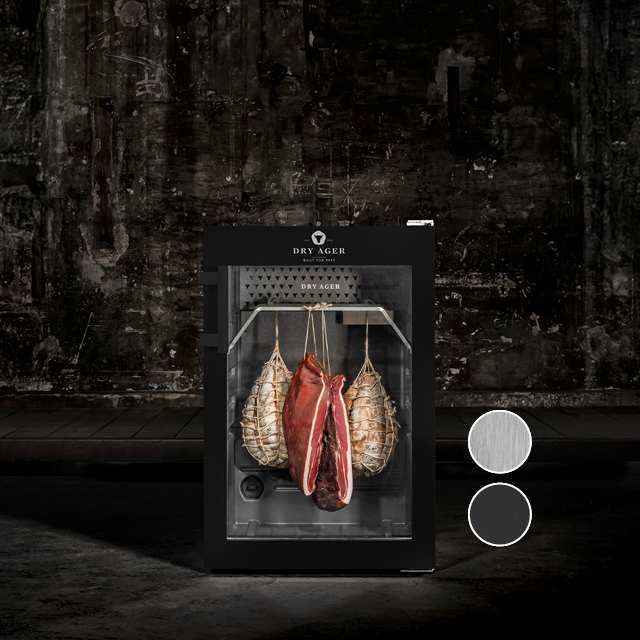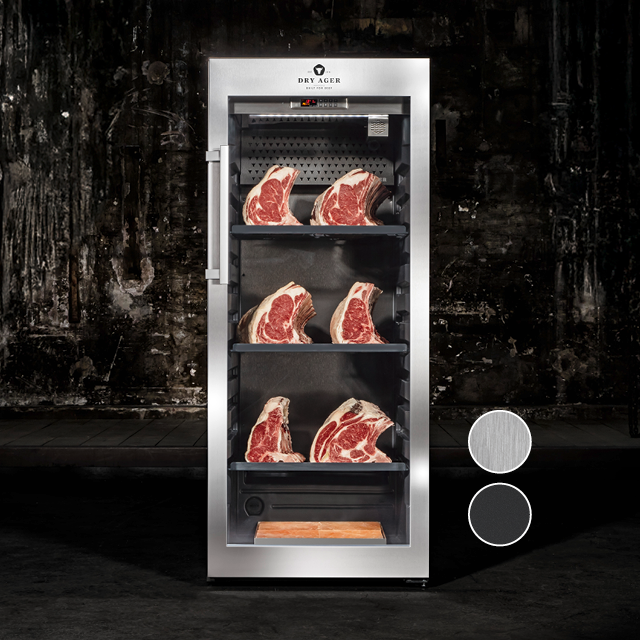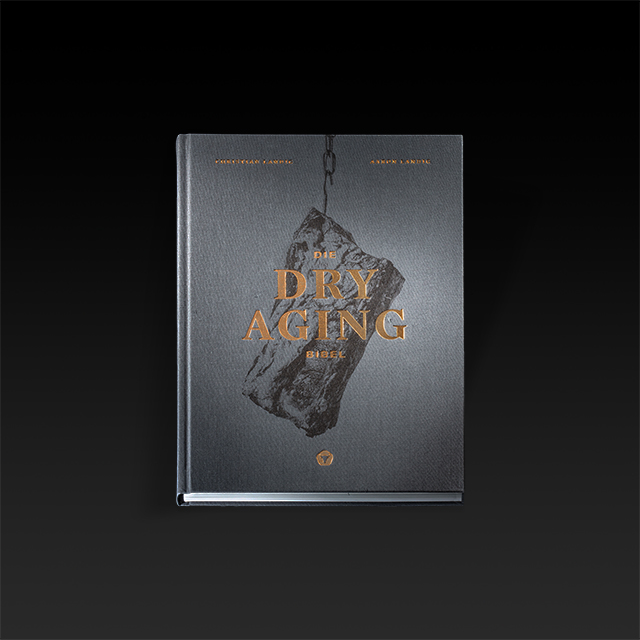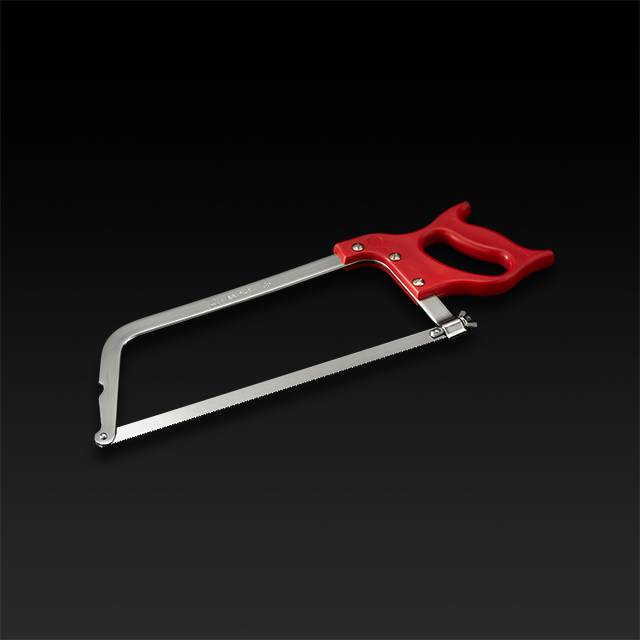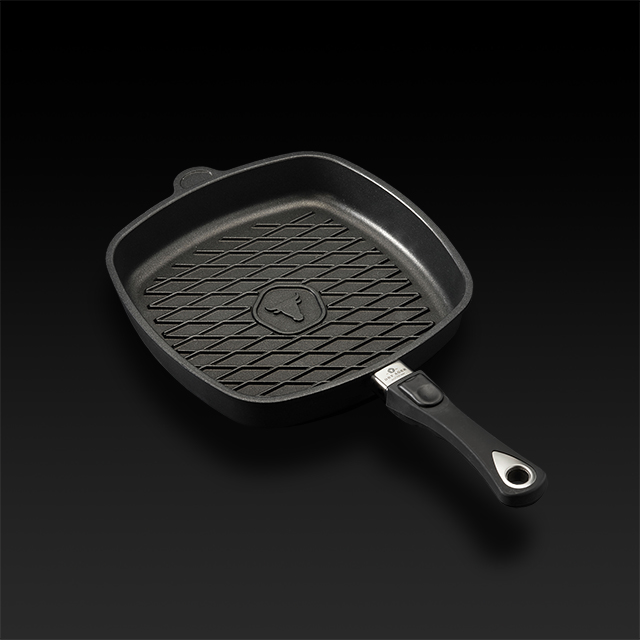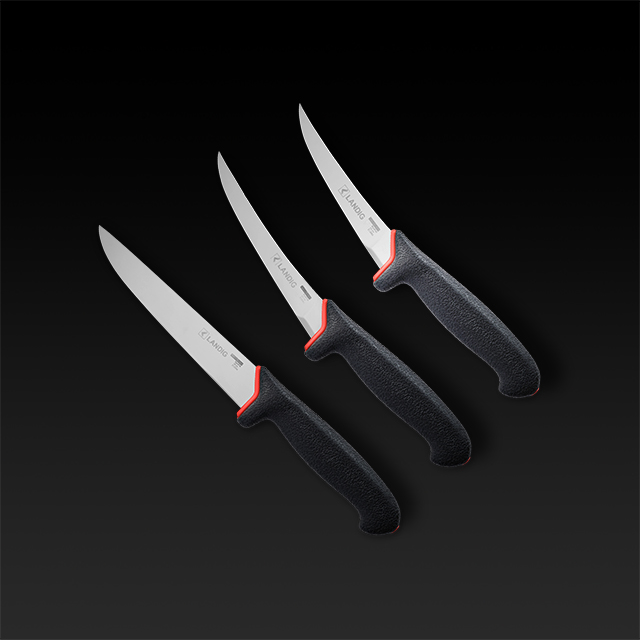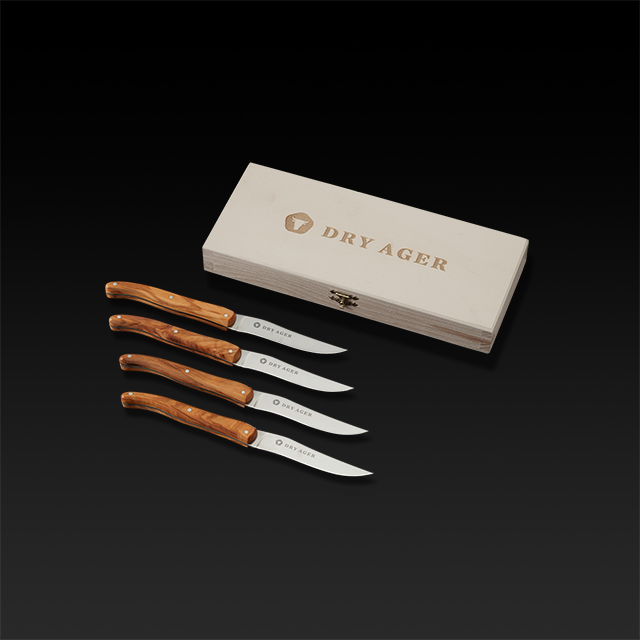MAGAZINE ARTICLE IN BEEF! ® ISSUE 06/15

We would like to introduce a very special testimonial report from an employee of the magazine “BEEF!“. They tested our meat maturing fridge DRY AGER and have widely reported it in their publication. The following report is a quote from the magazine issue 06 /2015. You can download the article as a PDF: BEEF! Article 06/2015.
The meat was matured by ourselves as reported below!
After nearly four weeks in the “BEEF! Dry Ager”, the first maturity refrigerator for your home, we enjoyed a blast of madness. Read how we have made sirloin a delicacy and how to bring this fun to your home.
Photos: Thomas Neckermann & Frank Stöckel
Recipes & Food Styling: Achim Ellmer & Marcel Stut
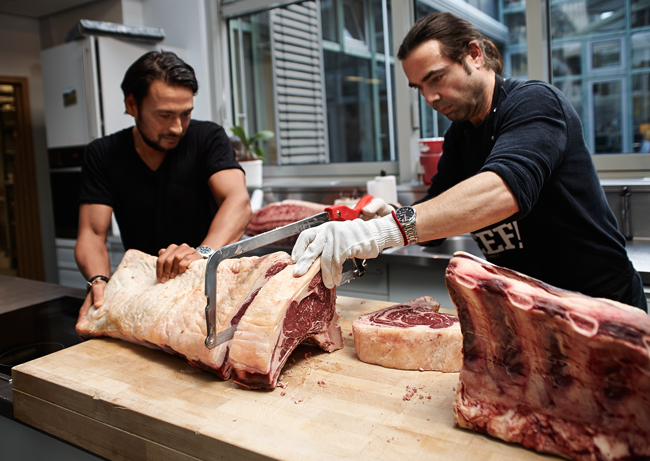
Is there anything better than when old methods suddenly have new meaning and these are refined after decades gone by? The original method of dry aging was to mature exposed meat on the bone in a dry atmosphere. In the 1960’s wet aging in a vacuum bag took over. However, the perfected art of dry aging returned initially to fine steakhouses and butchers – but now, finally, to all of us. Namely, in the form of “BEEF! Dry Ager”. The company Landig, Swabian family and world leader in game refrigerators, have developed the meat maturing fridge for the home. The same size as a standard domestic refrigerator: 1.65 m high, 70 cm wide, 75 cm deep, weighing slightly heavier at 90 kilos, it can stand alone anywhere in the home or fit under a work surface in the kitchen. A standard electrical outlet is sufficient. Thanks to modern cooling technology it’s far more hygienic than many commercial maturing rooms in the butchers. The DRY AGER can take up to 100 kilos of meat at any one time, from beef, lamb or pork, as whole backs or already portioned. Leave it to mature to achieve the perfect meat to your taste. Think ahead – if you have an event, you must allow time to produce such fine steaks.
Hanging
Shoulder lift and bend: Chef Achim Ellmer even sinks to his knees.
1 / PREPARING
The unit is cleaned, the inner side walls cleaned with disinfectant, the salt blocks arranged at the bottom and the two hangers consecutively inserted into the uppermost support rails. Once the ideal values are set (1.5 degrees internal temperature, 85% humidity) the DRY AGER is ready for the meat.
2 / HANGING
In each case a swivel hook per loin is inserted between two ribs through the flesh, namely the upper, thicker end. Instead of piercing the hook into the flesh, one can also use a fixed line as an anchor. The entire procedure should take no longer than one hour, not allowing the meat to get warm.
3 / PULLING
Only when the meat is properly secured and no longer needs to be moved, the protective film can be removed from the meat. Thereafter, it is recommended to wear latex gloves if the meat is to be handled.
4 / ADJUSTING
The loins should be hung in the DRY AGER but must not touch one another or any of the inner walls of the fridge. Do not allow the meat to stand on floor – so no wet spots or mould can form.
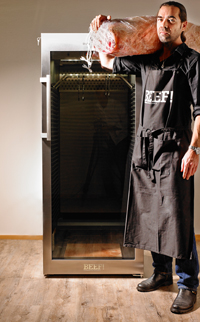
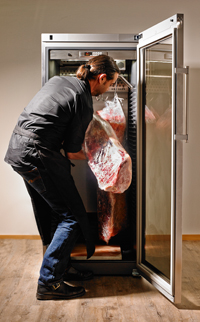
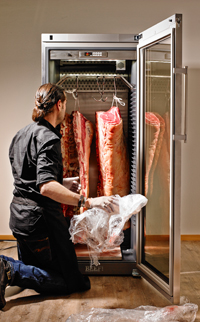
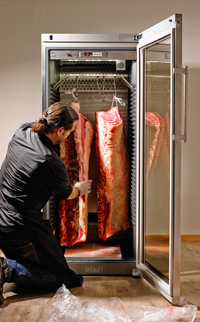
The five most important rules in this process:
- Buy your MEAT from slaughter houses which operate high hygiene standards. Rare breeds are always the best. These have better flavour and good ratio of marbling. For beef, Angus and Hereford are a good choice.
- It’s very important to keep stringent HYGIENE standards during the whole dry aging process : for direct contact with meat always wear latex gloves.
- The HUMIDITY should be checked at intervals. With a clean cloth, gently wipe any moisture/ blood that may collect on the floor of the fridge.
- The AIR must be able to circulate freely around the meat. Check the loins during the maturing process. Occasionally, rotate them (wearing gloves) so that they dry as evenly as possible.
- The DURATION of the process depends on the type of meat. The tenderness of the meat develops in the first 2 – 3 weeks, after this it improves in flavour. Lamb should take no longer than two weeks, pork no more than three and beef no longer than six weeks.
The Dry Aging of BEEF
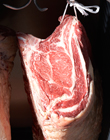 Day 1: A loin from a heifer weighing 24.65 kilos is bought fresh from the slaughterhouse and hung
Day 1: A loin from a heifer weighing 24.65 kilos is bought fresh from the slaughterhouse and hung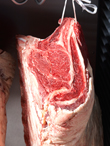 Day 8: Within these first few days the enzymes start to break down and soften the meat
Day 8: Within these first few days the enzymes start to break down and soften the meat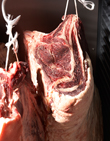 Day 14: The outer fat oxidizes and develops a nutty aroma, which circulates in the fridge
Day 14: The outer fat oxidizes and develops a nutty aroma, which circulates in the fridge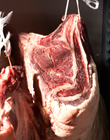 Day 20: The colour develops to a reddish brown of black pudding. Whilst the exposed meat forms a hard crust
Day 20: The colour develops to a reddish brown of black pudding. Whilst the exposed meat forms a hard crust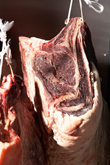 Day 26: The loin will now weigh 23 kilos. It has lost 1.65 litres of fluid
Day 26: The loin will now weigh 23 kilos. It has lost 1.65 litres of fluidThe Dry Aging of Pork
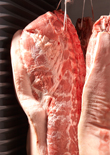 Day 1: A smaller loin taken from a rare breed pig weighing 15.05 kilos begins the maturing process
Day 1: A smaller loin taken from a rare breed pig weighing 15.05 kilos begins the maturing process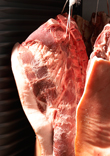 Day 7: Small droplets of fluid will form on the base of the fridge indicate that the pork is drying much faster than the beef
Day 7: Small droplets of fluid will form on the base of the fridge indicate that the pork is drying much faster than the beef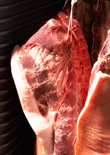 Day 11: More moisture is lost intensifying the natural flavour of the meat
Day 11: More moisture is lost intensifying the natural flavour of the meat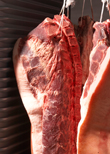 Day 18: As each day passes the smell of ham and freshly baked bread will be apparent when you open the fridge door
Day 18: As each day passes the smell of ham and freshly baked bread will be apparent when you open the fridge door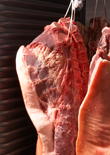 Day 21: The pork has lost 1.45 litres of fluid and weighs in the end only 13.60 kilos
Day 21: The pork has lost 1.45 litres of fluid and weighs in the end only 13.60 kilosThe Butchering
Now you are your own butcher: In eight steps cut the perfect steaks from the loins of the Beef and Pork
Beef Butchering
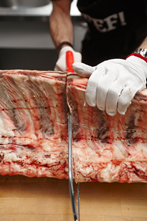 1/ CUT
1/ CUTThe exposed meat has formed a crust. Trim off 1-2cms from both ends. These are not suitable for eating. Now separate the forerib section from the rest of the strip loin using a saw/knife. Don’t forget to wear safety gloves!Now the bone saw comes into play …
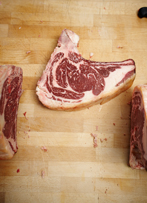 2/ SAWING
2/ SAWINGCarefully saw through the bone taking care not to rip the flesh. A 5cm thick T Bone steak is now in front of you. A total of 4 T Bones can be cut.
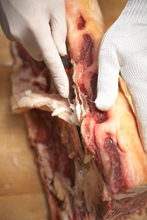 3/ CUT
3/ CUTLoosen the meat from the top side of the bone with a sharp knife.
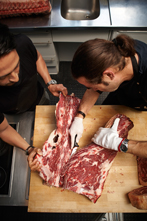 4/ SEPARATE
4/ SEPARATECut along the bone surface to release the strip loin
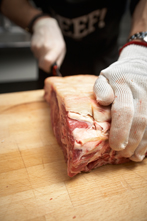 5/ PORTION
5/ PORTIONFrom the strip loin cut with a knife about 3 – 4 cm thick sirloin steaks.
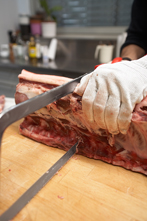 6 + 7/ CUTTING AND SAWING
6 + 7/ CUTTING AND SAWINGThe disection of the pork works exactly the same as beef: trim off dry patches, cut between the ribs, then saw through the bone carefully
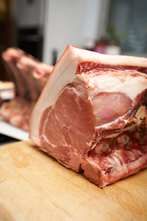 8/ PORTION
8/ PORTIONThe pork chops should be about 3cms thick, the rind is removed together with the fat
AND NOW YOU HAVE YOUR OWN CHOPS!
Now that you have matured and prepared the meat, why not cook it with one of these recipes:
Rump steak Asian style, classic sirloin steak with béarnaise sauce or pork sous vide …
SIRLOIN STEAK Teriyaki style
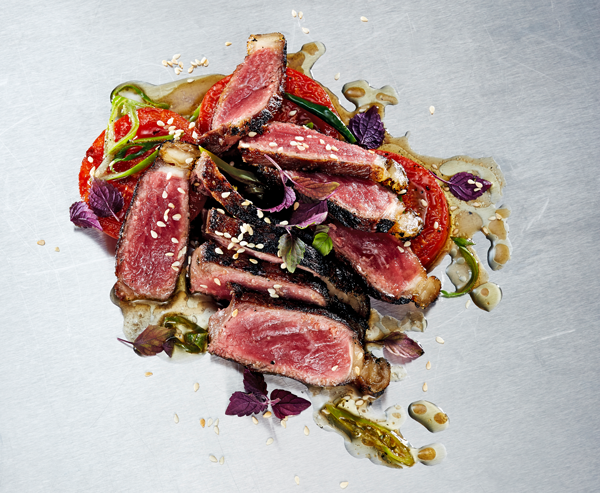
Serves 4
2 tablespoons bonito fish flakes, 1 piece of fresh ginger (approximately 4 x 4 cm), 75 ml Mirin (or Sake), 100ml light soy sauce, a little sugar, 75 ml of lemon juice, 2 sirloin steaks (dry aged, 300g), 2 tsp sesame seeds, 3 tomatoes, sea salt, 2 tablespoons olive oil, 2 spring onions, 2 tablespoons butter, pepper, 1 Beet shiso cress
PREPARATION
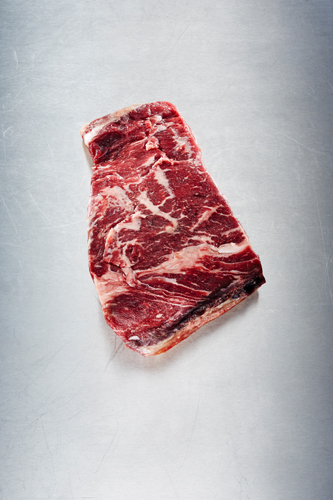
- For the sauce combine in a pan the bonito flakes, mirin, soy sauce and 1 teaspoon of sugar and bring to the boil. Remove from heat and stand for about 1 hour. Strain the sauce through a fine sieve and stir in the lemon juice.
- Bring the steaks to room temperature. Fry the sesame seeds in a non-stick frying pan. Wash tomatoes, dry them and cut in half horizontally, season with salt and sugar. Heat oil in a pan and with the cut side down fry the tomatoes for 2-3 minutes on a high heat. Remove and set aside.
- Pre-heat the Beefer (alternatively heat grill pan with oil) for 5 minutes. Grill the meat 10cms away from the burner for about 2 minutes on each side (in the pan fry for about 2-3 minutes). Then let it rest for about 5 minutes.
- Meanwhile, wash the spring onions. Warm the sauce and melt in the butter. Add the spring onions, mix and season with pepper. Cut the cress.
- Slice the meat into strips and serve with the tomato, sauce and serve sprinkled with sea salt, cress and sesame seeds.
- Preparation time: 30 minutes (plus 1 hour marinating time)
Entrecote with bearnaise sauce
Serves 4
4 Entrecote steaks (dry aged, 300g), 2 tablespoons olive oil, sea salt, freshly ground pepper
ZUBEREITUNG
- Bring the steaks to room temperature and set aside.
- In a heavy based pan heat the oil on high heat. Place 2 steaks in the pan and fry on high heat for 3 minutes per side, season with salt and pepper. Wrap steaks in foil and let them rest for about 8 minutes. In the meantime, cook the remaining steaks and repeat process.
- Serve with the Bearnaise sauce (recipe below).
- Preparation time: about 20 minutes (plus resting time of meat)
Béarnaise sauce
Zutaten:
2 shallots, 2 tablespoons white wine vinegar, 150ml dry white wine, 1 teaspoon dried tarragon, 250 g butter, 4 fresh egg yolks (gr. M), salt, pepper, 1 – 2 tablespoons lemon juice, 3 stalks of fresh tarragon
PREPARATION
- Dice the shallots finely, place in a saucepan together with white wine vinegar, white wine and dried tarragon and reduce to 100ml. Strain through a fine sieve and set aside to cool.
- Lightly beat egg yolks with one teaspoon of water. Stir the egg yolk mixture into the cooled vinegar, then add the lemon juice. Pour the mixture into a bowl suspended over a pan of simmering water (do not allow base of the bowl to touch the water). Whisk constantly until the sauce has thickened enough to coat the back of a spoon and has increased in volume. Remove the bowl from the heat and slowly pour in the clarified butter in a steady stream, whisking continuously, until the mixture is thick and smooth. Fold in the tarragon leaves and season, to taste, with salt and freshly ground black pepper.
- Preparation time: 20 minutes
DRY AGED PORK LOIN WITH VINAIGRETTE
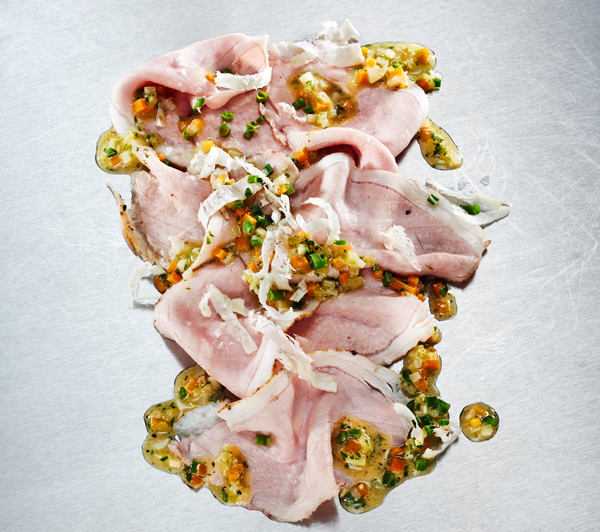
Serves 4
600g dry aged pork, sea salt, pepper, 50g carrot, 50g parsley, 50g leek, 50g celery, 3 tablespoons of sunflower oil, 2 tablespoons cider vinegar, 100 ml chicken stock (fresh or shop bought), 1 – 2 tablespoons medium hot mustard, 4 tablespoons grapeseed oil, some sugar, 1 tablespoon butter, 6 stalks of parsley, ½ bunch of chives, some freshly grated horseradish
PREPARATION
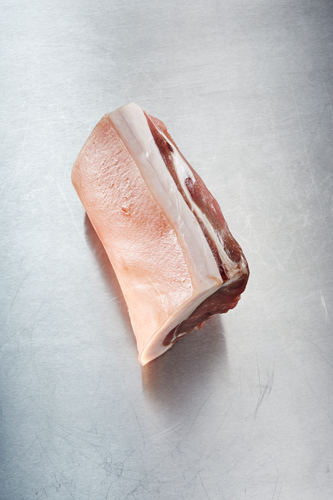
- Take the meat out of fridge 2 hours beforehand. Pat it dry, remove the rind and about two-thirds of the fat cover. Season the meat with salt and pepper and vacuum pack it. In a water bath set at 60 degrees, cook for two hours. Or alternatively after seasoning meat, fry with 2 tablespoons of oil in an oven proof pan, then pour in 200ml of water and 1 tablespoon of softened butter and place in a conventional over at 160 degrees for about 45-50 minutes.
- In the meantime, for the vinaigrette, peel the carrot and parsley and chop finely. Clean the leek and celery and also finely chop.
- In a small saucepan heat 2 tablespoons sunflower oil, add diced vegetables and sauté for 1-2 minutes. Deglaze the pan with vinegar, add the chicken stock and let it boil a little. Stir in mustard and grape seed oil and season with salt, pepper and 1 pinch of sugar. Let the vinaigrette cool until lukewarm.
- Remove the meat from the bag and pat dry. Heat butter and remaining sunflower oil in a pan. Brown the meat quickly. Remove from pan, let it rest briefly and then cut into thin slices.
- Arrange the meat slices on the plates. Chop parsley coarsely, mix with the vinaigrette. Cut chives into small rings. Pour vinaigrette over the meat and sprinkle with sea salt, horseradish and chives.
- Preparation time: 20 minutes (plus resting and about 2 hours cooking time)
